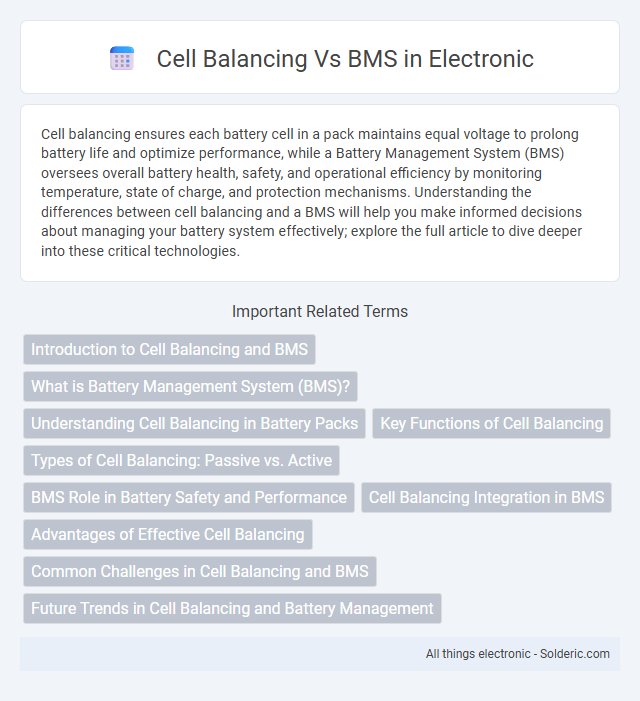Cell balancing ensures each battery cell in a pack maintains equal voltage to prolong battery life and optimize performance, while a Battery Management System (BMS) oversees overall battery health, safety, and operational efficiency by monitoring temperature, state of charge, and protection mechanisms. Understanding the differences between cell balancing and a BMS will help you make informed decisions about managing your battery system effectively; explore the full article to dive deeper into these critical technologies.
Comparison Table
| Feature | Cell Balancing | Battery Management System (BMS) |
|---|---|---|
| Definition | Process of equalizing charge levels across battery cells | Comprehensive system that monitors and manages battery health and performance |
| Main Function | Ensures uniform voltage and capacity among cells | Monitors voltage, current, temperature, and state of charge; protects battery |
| Scope | Focuses solely on charge equalization | Includes cell balancing, safety, diagnostics, and communication |
| Types | Passive balancing, Active balancing | Integrated systems with multiple sensors and control units |
| Importance | Prevents overcharging or undercharging of individual cells | Maximizes battery life, safety, and performance |
| Application | Used within BMS to maintain cell uniformity | Used in electric vehicles, renewable energy storage, and portable electronics |
Introduction to Cell Balancing and BMS
Cell balancing is a crucial process within Battery Management Systems (BMS) that equalizes voltage and capacity across individual cells to enhance battery performance and longevity. A BMS monitors, protects, and manages battery cells by controlling charge and discharge rates, ensuring safety, and optimizing energy usage. Understanding the interplay between cell balancing and BMS functionality helps you maintain efficient and reliable battery operation.
What is Battery Management System (BMS)?
A Battery Management System (BMS) is an electronic control unit designed to monitor and manage individual cell voltages, temperatures, and state of charge within a battery pack, ensuring optimal performance and safety. It prevents overcharging, deep discharge, and cell imbalance by actively balancing cells through techniques like passive or active balancing. Your battery's longevity and reliability depend significantly on an efficient BMS that maintains cell health and overall system stability.
Understanding Cell Balancing in Battery Packs
Cell balancing is a crucial process within a Battery Management System (BMS) that ensures all individual cells in a battery pack maintain equal voltage levels for optimal performance and longevity. Without proper cell balancing, some cells may become overcharged or undercharged, leading to reduced capacity, premature aging, and potential safety hazards. Your BMS actively manages this balancing by redistributing charge among cells, optimizing overall battery efficiency and reliability.
Key Functions of Cell Balancing
Cell balancing ensures uniform voltage levels across individual battery cells, preventing overcharging or deep discharge that can degrade battery lifespan. It regulates energy distribution by equalizing charge, enhancing overall battery pack performance and safety. Key functions include passive balancing using resistors to dissipate excess energy and active balancing that redistributes charge between cells for optimal efficiency.
Types of Cell Balancing: Passive vs. Active
Passive cell balancing dissipates excess energy from higher voltage cells as heat through resistors, offering a simpler and cost-effective solution for maintaining battery pack uniformity. Active cell balancing transfers energy from higher voltage cells to lower voltage cells using inductors, capacitors, or transformers, enhancing efficiency and extending battery life by reducing energy loss. Battery Management Systems (BMS) integrate these balancing methods to optimize performance, ensure safety, and prolong the lifespan of lithium-ion battery packs.
BMS Role in Battery Safety and Performance
A Battery Management System (BMS) plays a critical role in maintaining battery safety and performance by continuously monitoring cell voltages, temperatures, and charge levels to prevent overcharging, overheating, and deep discharge. Cell balancing, a key function within the BMS, ensures uniform charge distribution across all cells, maximizing overall battery lifespan and efficiency. Your battery's reliability and safety depend heavily on the BMS's ability to perform precise cell balancing and real-time condition monitoring.
Cell Balancing Integration in BMS
Cell balancing is a critical function integrated within Battery Management Systems (BMS) to ensure uniform voltage distribution across individual cells in a battery pack, preventing overcharging or deep discharging. Advanced BMS employ active or passive cell balancing techniques, utilizing real-time voltage monitoring and control algorithms to enhance battery lifespan and performance. Effective cell balancing integration in BMS improves overall safety, efficiency, and longevity of lithium-ion battery systems by maintaining optimal charge equilibrium.
Advantages of Effective Cell Balancing
Effective cell balancing enhances battery performance by ensuring uniform voltage across all cells, which maximizes energy utilization and extends battery life. It prevents overcharging and deep discharge of individual cells, reducing the risk of damage and maintaining overall system safety. Your battery management system (BMS) with advanced cell balancing capabilities improves reliability and efficiency in energy storage applications.
Common Challenges in Cell Balancing and BMS
Cell balancing and Battery Management Systems (BMS) face common challenges such as accurate state-of-charge measurement, thermal management, and ensuring voltage uniformity across battery cells. You need to address issues like cell aging, voltage drift, and inconsistent charge/discharge rates that can degrade battery performance and lifespan. Effective integration of cell balancing techniques within the BMS is essential to optimize battery efficiency and prevent safety risks.
Future Trends in Cell Balancing and Battery Management
Future trends in cell balancing and battery management systems (BMS) emphasize advanced algorithms integrating artificial intelligence for predictive maintenance and real-time state-of-health optimization. Emerging BMS technologies leverage machine learning to enhance accuracy in cell voltage, temperature monitoring, and equalization, improving overall battery lifespan and efficiency. Increasing adoption of wireless BMS architectures enables scalable, modular solutions for electric vehicles and renewable energy storage, driving innovation in smart battery management.
Cell balancing vs BMS Infographic

 solderic.com
solderic.com